
Lomatium is a genus of about 75 species of perennial herbs native to western North America; its common names include biscuitroot, Indian parsley, and desert parsley. It is in the family Apiaceae and therefore related to many familiar edible species such as carrots and celery; some Lomatium species are extensively used by Native Americans in the inland Northwest as a staple food.
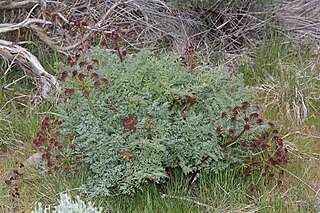
Lomatium dissectum is a species of flowering plant in the carrot family known by the common name fernleaf biscuitroot. It is native to much of western North America, where it grows in varied habitat. It is found in the eastern slopes of the Cascade Range, Rocky Mountains, Klamath Mountains, eastern Transverse Ranges and the Sierra Nevada in California.

Lomatium macrocarpum is a perennial flowering plant in the carrot family known by the common names bigseed lomatium, biscuit root or bigseed biscuitroot. It is native to much of western North America, where it can be found in various types of habitat, including the grasslands of the Great Plains. It is spreading or erect perennial herb growing up to about half a meter long with hairy, gray-green herbage. The leaves are up to about 24 centimeters long and are intricately divided into many small, narrow segments. The inflorescence bears an umbel of yellowish, purplish, or white flowers. The fruit is a compressed, winged, round or oval disc up to about 2 centimeters long.
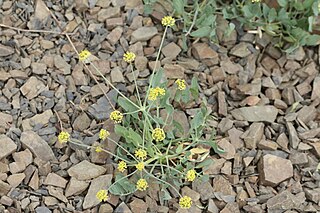
Lomatium nudicaule is a species of flowering plant in the carrot family known by the common names pestle lomatium, barestem biscuitroot, Indian celery and Indian consumption plant. It is native to western North America from British Columbia to California to Utah, where it is known from several habitat types, including forest and woodland. It is a perennial herb growing up to about 70 centimeters tall from a thick taproot. It generally lacks a stem, the inflorescence and leaves emerging from ground level. The leaves are made up of many dull green, waxy lance-shaped leaflets each up to 9 centimeters long. The inflorescence is borne on a stout peduncle widening at the top where it blooms in an umbel of yellow or purplish flowers.

Lomatium canbyi is a species of flowering plant in the carrot family known by the common name Canby's biscuitroot. It is native to the Pacific Northwest of the United States and northeast California, where it grows in sagebrush-covered plateau habitat and barren flats.
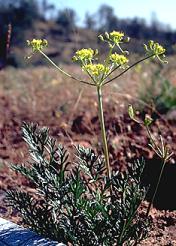
Lomatium congdonii, known by the common names Mariposa desertparsley and Congdon's lomatium, is a species of flowering plant in the carrot family.

Lomatium foeniculaceum is a species of flowering plant in the carrot family known by the common name desert biscuitroot. It is native to much of western and central North America, where it grows in many types of habitat.

Lomatium grayi, commonly known as Gray's biscuitroot, Gray's desert parsley, or pungent desert parsley, is a perennial herb of the family Apiaceae. It is native to Western Canada in British Columbia, and the Western United States, including from the Eastern Cascades and northeastern California to the Rocky Mountains.

Lomatium caruifolium, known by the common name alkali desertparsley, is a species of flowering plant in the carrot family.
Lomatium ciliolatum is a species of flowering plant in the carrot family known by the common name Yolla Bolly biscuitroot. It is endemic to California, where it is known from the mountain ranges adjacent to the north and south of the San Francisco Bay Area, at 300–600 feet, 1200–2100 m. It is often a member of the serpentine soils flora in woodland and chaparral habitat.

Lomatium howellii is an uncommon species of flowering plant in the carrot family known by the common name Howell's biscuitroot, or Howell's lomatium. It is native to the Klamath Mountains of southern Oregon and northern California, where it is a member of the local serpentine soils flora.
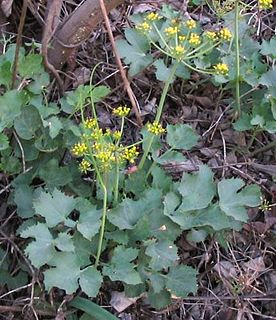
Lomatium lucidum is a species of flowering plant in the carrot family known by the common name shiny biscuitroot. It is native to coastal mountains and canyons of southern California and Baja California, where it is a member of the chaparral plant community, including recently burned areas. It is found in the eastern Transverse Ranges and the South Coast region.

Lomatium nevadense is a species of flowering plant in the carrot family known by the common name Nevada biscuitroot. It is native to the western United States and northern Mexico, where it is known from several different habitat types, including sagebrush and woodlands. It is a perennial herb growing up to about 45 centimeters tall from a taproot. The leaves are up to about 16 centimeters long, their blades divided into many oblong pointed segments. The inflorescence is an umbel of white or cream flowers.

Lomatium parvifolium is an uncommon species of flowering plant in the carrot family known by the common names coastal biscuitroot and small-leaved lomatium. It is endemic to California, where it is known only from the Central Coast and central California Coast Ranges. It grows in pine forests and other habitat on serpentine soils.
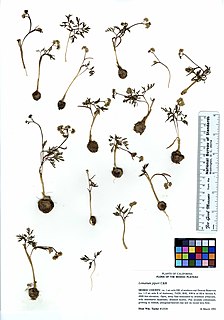
Lomatium piperi is a species of flowering plant in the carrot family known by the common name salt-and-pepper or Indian biscuitroot. It is native to the Northwestern United States and northern California, where it grows in sagebrush and plateau habitat, and the Sierra Nevada and Cascade Mountains.
Lomatium repostum is an uncommon species of flowering plant in the carrot family known by the common name Napa biscuitroot, or Napa lomatium. It is endemic to California, where it is known only from the northrthern California Coast Ranges surrounding the northern San Francisco Bay Area. It often grows in plant communities on serpentine soils.

Lomatium rigidum is a species of flowering plant in the carrot family known by the common names Big Pine biscuitroot and stiff lomatium. It is endemic to Inyo County, California, where it is known only from the wilderness around the Big Pine area of the Owens Valley.

Lomatium triternatum is a species of flowering plant in the carrot family known by the common name nineleaf biscuitroot. It is native to western North America from British Columbia to California to Colorado, where it grows in many types of habitat. It is a hairy perennial herb growing up to a meter tall from a taproot. The leaves emerge from the lower part of the stem. Each is generally divided into three leaflets which are each subdivided into three linear leaflike segments. The inflorescence is an umbel of yellow flowers, each cluster on a ray up to 10 centimeters long.

Lomatium greenmanii is a rare species of flowering plant in the carrot family known by the common names Greenman's desertparsley and Greenman's biscuitroot. It is endemic to Oregon in the United States, where it is found only in the Wallowa Mountains of Wallowa County.

Lomatium latilobum is a species of flowering plant in the carrot family known by the common names Canyonlands lomatium and Canyonlands biscuitroot. It is native to an area straddling the border between Utah and Colorado in the United States, where several of its few occurrences are within Arches National Park and Colorado National Monument.


















